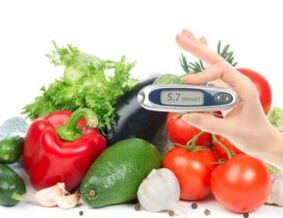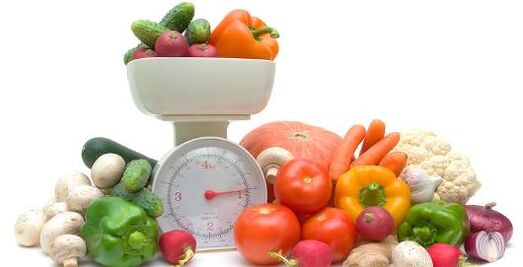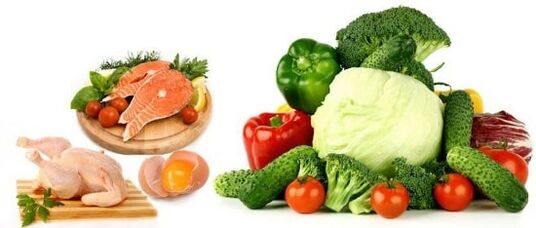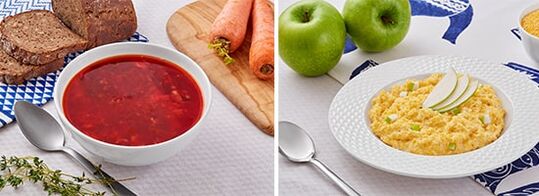
Diabetes mellitus is a chronic endocrine pathology in which the metabolism is disturbed due to lack or improper action of the hormone insulin.
There are insulin-dependent diabetes (type 1) and non-insulin-dependent diabetes (type 2).
In the first case, patients have to inject insulin preparations by injection, as the hormone in their body is produced in insufficient quantities or is completely absent.
In the second type, the interaction of insulin with cells is disrupted.
Despite the different mechanisms of pathology development, the main role in its therapy is assigned to dietary food.
Dietary Characteristics for Diabetics
In the past, a food restraint system was the only way to curb hyperglycemia, or high glucose levels. Now the patients's diet has expanded significantly. Diabetics are advised to follow some important rules for effective blood glucose control.
Patients should not be hungry or overeat. These conditions are dangerous to their health. You need to eat so that the amount of carbohydrates consumed is evenly distributed throughout the day.
General dietary requirements:
- partial food (at least 6 times a day);
- calculation of carbohydrates consumed;
- restriction of animal fats;
- introduction of plant foods in the diet;
- preference for steamed, oven-cooked food;
- avoiding or limiting carbohydrate load foods;
- Balanced diet;
- replacing sugar with substitutes;
- consumption of high-fiber foods;
- compliance with the drinking regime;
- reducing salt intake;
- elimination of alcohol.
You can diversify your diet by purchasing tools that allow you to cook food without oil.
In order for carbohydrates to be absorbed more slowly and not provoke jumps in raising blood sugar, it is worth adhering to the following recommendations:
- Eat thick or whole grains, such as whole grains instead of baked or cooked cereals.
- Food should not be hot as temperature affects glucose uptake.
- Fiber in foods inhibits the absorption of simple carbohydrates and helps remove cholesterol.
- Simple carbohydrates are best consumed after the main meal.
The menu may include foods that contain simple carbohydrates with fiber, such as fruits and berries. Glucose absorption is slowed down if consumed with protein (protein cream) or fats. However, remember that "slow" carbohydrates are also absorbed into the bloodstream, raising sugar.

Differences in nutrition in type 1 and type 2 diabetes mellitus
Since the reasons for the rise in blood sugar in the first and second type of disease are different, there are several approaches to patients's diet. For insulin-dependent patients, the diet is more varied. As they suffer from this pathology more often at a young age, high-calorie foods are also included in the diet. When compiling a diet, the units of grain consumed are taken into account.
In type 2 diabetes, the main task of nutrition is weight loss. In this case, the menu is calculated according to the caloric content of the products. The patient's diet is more rigid. They are not allowed sugar, fatty foods and foods that raise cholesterol.
Bread unit

The concept of "bread unit" (XE) was introduced to calculate the quantitative composition of carbohydrates. For 1 XE, it is considered to be 25 g of bread or 12 g of sugar (carbohydrates). A diagram of bread units is needed for diabetics to calculate the short insulin administered.
1 XE requires 2-4 units. insulin. The individual need for additional insulin administration according to XE is determined using a self-monitoring diary, which should be kept by the patient.
At one meal, a diabetic should eat no more than 7 XE. The main load of carbohydrates occurs in the first half of the day.
In order not to constantly calculate bread units by weight of products, we created product tables taking into account their energy value.
What is the glycemic index of foods
The glycemic index (GI) is an indicator that shows how much blood sugar can be increased by using a certain product compared to glucose intake.
High GI foods (70 or more):
- honey,
- glucose;
- sugar;
- Mashed potatoes;
- sweet soda;
- sweets - corn sticks, puffed rice.
GI average (56-69):
- melon;
- banana;
- bollgur;
- black bread.
The lowest GI has:
- dairy products;
- milk;
- fruits;
- peas, beans, lentils and other legumes.
The rate of absorption is affected by cooking, food integrity and temperature.
In diabetes mellitus, only foods with medium and low GI are allowed.
List of permitted and prohibited products
The principles of a diet for diabetics with different types of diseases differ. However, there are dishes that endocrinologists do not recommend eating.
The list of prohibited foods includes:
- chips, chips, chips;
- sweet fruits - grapes;
- fatty meats;
- smoked meat;
- canned food in oil;
- Potatoes;
- sweet cottage cheese, curd mass;
- sweet yogurt;
- margarine;
- white bread and pastries with white flour;
- juices from the store;
- soda;
- alcohol;
- sweets, chocolates;
- blockage;
- condensed milk;
- Fast food.
Patients will need to fall in love with these foods and drinks:
- Mineral water;
- pink compote;
- vegetable juices;
- freshly squeezed juices from sweet and sour berries and fruits;
- sugar-free citrus;
- frozen and fresh berries;
- low-fat dairy products without sugar;
- Dietary meats - chicken, turkey, beef, rabbit;
- cabbage;
- legumes;
- mushrooms;
- tomatoes;
- eggplant;
- vegetables;
- asparagus;
- broccoli;
- milk;
- integral oven products;
- seafood;
- fish.
To reduce the starch content of vegetables and cereals, it is recommended to soak them before cooking.
Menu compilation rules
When compiling a menu, it is worth considering not only the carbohydrate load and calories of foods, but also the activity of diabetics. Exercise lowers blood sugar levels. In type 1 diabetes, it is recommended to eat 1 XE per hour of physical activity. This will prevent you from changing your bolus insulin dose.
With obesity, a dietitian helps to design a diet taking into account the energy content (calorie content) of foods and daily energy expenditure during physical activity. The calculation takes into account the gender, age and degree of obesity of the patient. It is allowed to organize fasting days (with type 2 diabetes). However, fasting is contraindicated in such patients.
The general condition of the diabetic is taken into account during the preparation of the menu. Pregnant and lactating women, adolescents and debilitated patients need protein intake. If the patient has kidney or liver damage, ketoacidosis, protein intake is reduced.
Do not forget about other nutrients that are involved in metabolism: vitamins, zinc, copper, manganese. Due to the tendency of patients to pathologies of the cardiovascular system, the salt content in the vessels decreases.
Example of a menu for a week
Monday
- breakfast: buckwheat porridge, protein bread with bran, butter, tea;
- snack: cabbage salad with eggs;
- lunch: chicken soup, vegetable salad with herbs, green beans with white meat, compote, diabetic rye bread;
- afternoon snack: yogurt bread;
- dinner: steamed zrazy with fish, rye bread, vegetable salad;
- snack: fermented milk drink.
Tuesday
- breakfast: oatmeal, whole grain bread with butter, tea;
- snack: salad with parsley, onion and mushrooms;
- lunch: pea soup, roasted chicken with vegetables, vegetable salad, whole grain bread, drinks;
- afternoon snack: baked milk fermented with biscuits;
- dinner: boiled fish with vegetables, wheat bread, juice;
- snack: kos.
Wednesday
- breakfast: porridge "Artek", protein bread with butter, coffee;
- snack: salad with celery, apples and carrots;
- lunch: borscht, buckwheat porridge with steamed kitten, salad with sauerkraut, bread with protein bran, compote;
- afternoon snack: cottage cheese with fruit;
- dinner: bigos with sauerkraut and meat, bread with protein bran, juice;
- snack: baked apple.
Thursday
- breakfast: eggs, rye bread with butter, tea;
- snack: cottage cheese with yogurt;
- lunch: green borscht, roasted eggplant with meat, tomato salad with low-fat sour cream, rye bread, compote;
- afternoon snack: cottage cheese pudding with tea;
- dinner: meat stew with vegetables, rye bread, drinks;
- snack: bread with kefir.

Friday
- breakfast: pearl barley porridge, whole grain bread with butter, tea (chicory, coffee);
- snack: fruit salad with yogurt;
- lunch: fish soup, fish kitten with vegetable garnish, salad with pepper and cucumber, whole grain bread, citrus drinks;
- afternoon snack: bread with milk;
- dinner: steamed cutlet with milk sauce, porridge, whole grain bread, lemonade;
- snack: fruit.
Saturday
- breakfast: beef omelette, whole wheat protein bread, tea;
- snack: cottage cheese with berries;
- lunch: mushroom soup, porridge with boiled (roasted) meat, canned peas with onions and herbs, bread with protein bran, compote;
- afternoon snack: oatmeal cookies with fermented baked milk;
- dinner: zucchini stuffed with meat, porridge, bread with protein bran, drinks;
- snack: fermented baked milk.
Sunday
- breakfast: brown rice with minced meat and cabbage (cabbage rolls), rye bread with butter, tea;
- snack: bread with yogurt;
- Lunch: meatball soup, chicken omelette, red cabbage salad, rye bread, drinks;
- afternoon snack: kefir with biscuits;
- dinner: fish cakes, baked potatoes, rye bread, drinks;
- snack: biscuits with milk.
The test menu was compiled by a nutritionist. In the future, the diabetic himself supplements the diet, taking into account the recommendations of the doctor.
Ready-to-eat foods for diabetics
To eat properly with diabetes mellitus, you have to spend a lot of time and effort. Most diabetics just do not have enough time to properly design the menu and prepare food, so now I would like to tell you about the company Cryodieta, which helps make life easier for people with diabetes.
Cryodieta is a delivery service for ready-made and delicious foods not only for diabetics, but also for those who want to lose weight. The menu was prepared by competent specialists - nutritionists and doctors.
Thanks to the use of a special technology "shock freezing", you just need to heat the food in a microwave or pot with plenty and eat a delicious meal. At the same time, freezing preserves all nutrients.
The main advantages of "Cryodiet":
- production of products in an ecologically clean area of the Novgorod region;
- late delivery in person;
- variety of foods;
- shock freezing (keeps food without preservatives);
- more affordable prices compared to competitors.
Examples of dishes

In big cities there is a ready-to-eat food delivery service for diabetics, so if you want to eat healthy food and not spend too much time on it, order a weekly menu on the official website.
Sugar substitutes
So that patients do not suffer from a lack of sweets, sweeteners can be added to the dishes. They are divided into three groups:
- Carbohydrates - fructose, sorbose, xylitol, sorbitol, molasses.
- Protein sweeteners - miraculin, monelin.
- Synthetic - aspartame, sodium cyclamate.
Endocrinologists recommend the use of the natural sweetener stevia. Its leaves contain a complex of glycosides, which is 200 times sweeter than sugar. The sweetener is beneficial for obesity, high cholesterol and high blood sugar. Due to its ability to normalize metabolism, stevia helps restore the antitoxic function of the liver.
Plant glycosides stimulate immunity, lower sugar levels and have a beneficial effect on the digestive and endocrine systems. Drinks containing stevia extract correct cravings for sugary and fatty foods and help you shed extra pounds.
High blood sugar is not a death sentence for patients if you learn how to make a diet and use healthy cakes instead of sugar. Also, do not forget about the mandatory consultation with an endocrinologist.































































